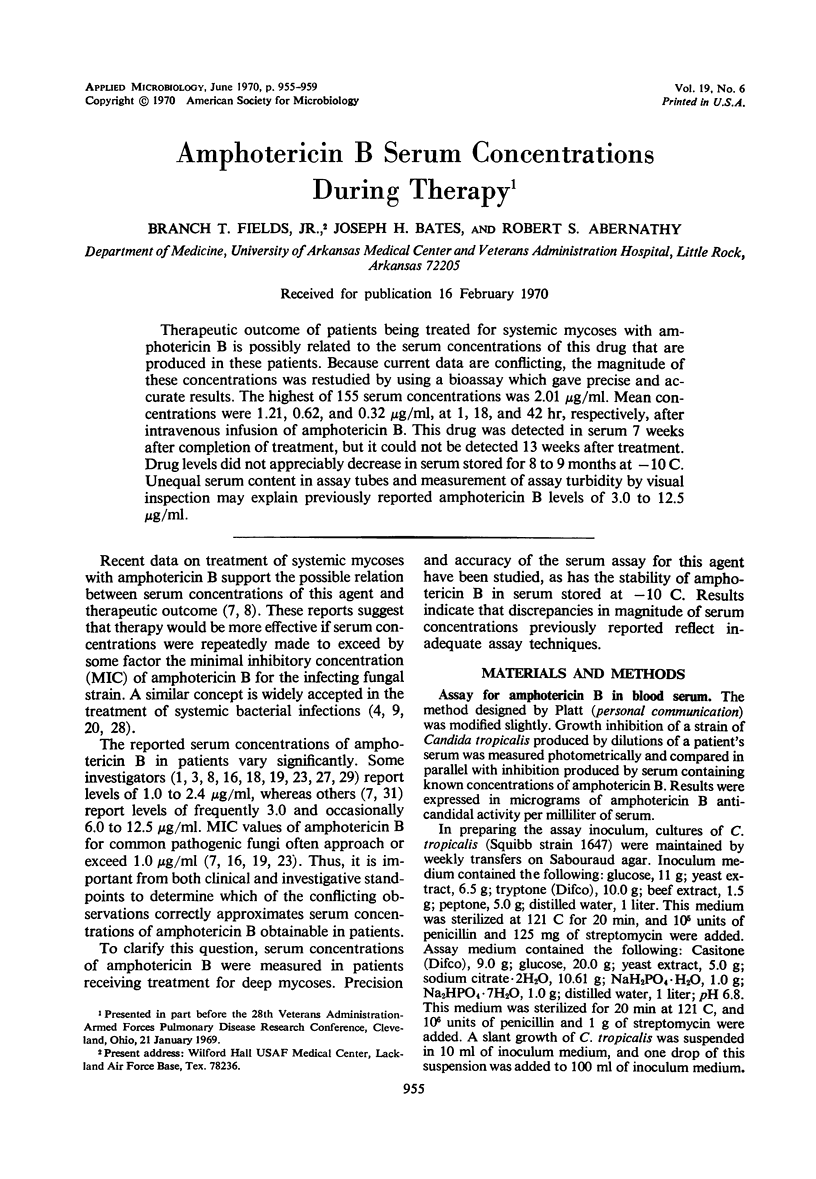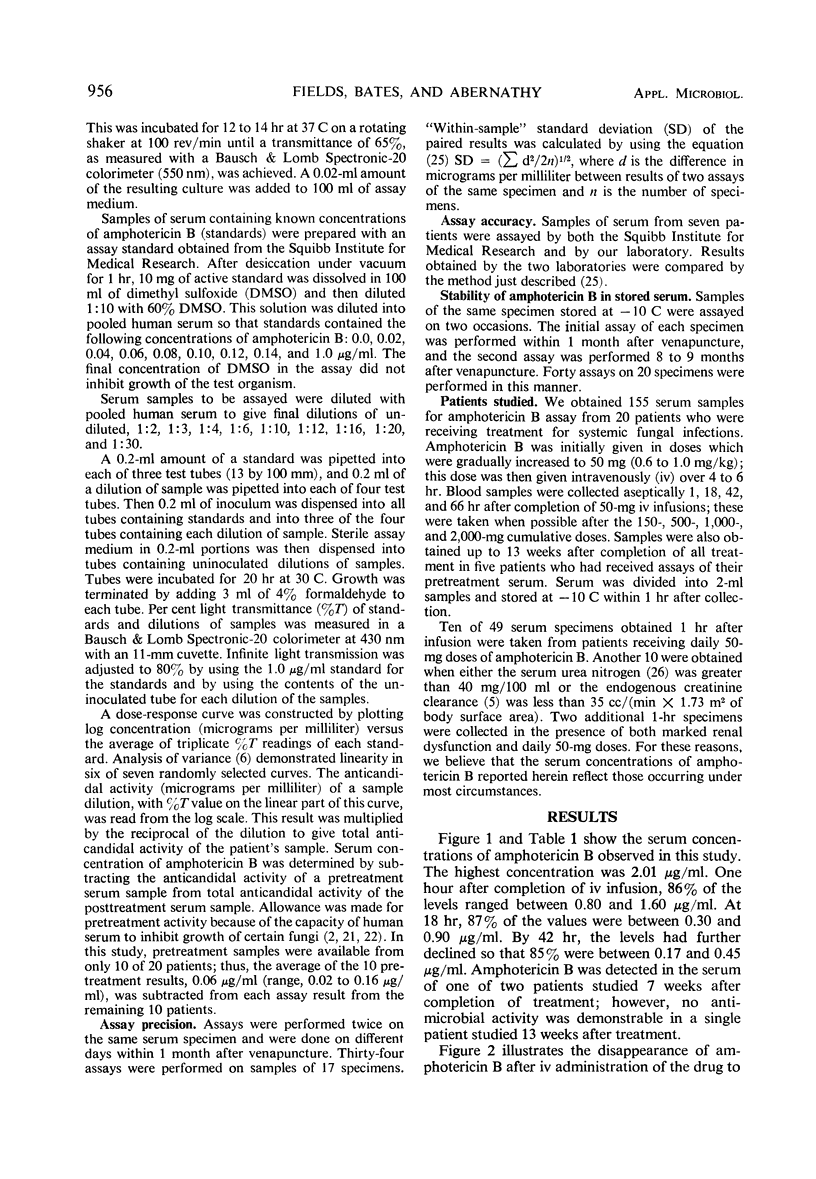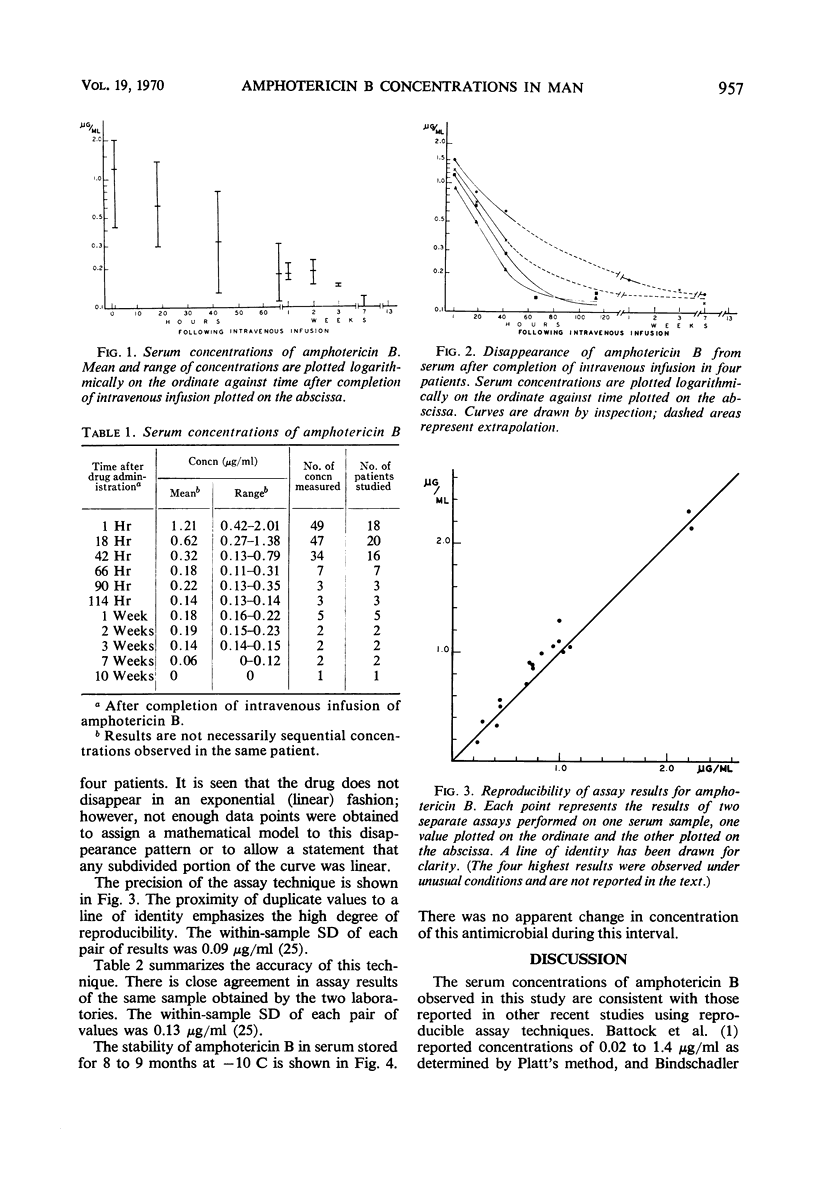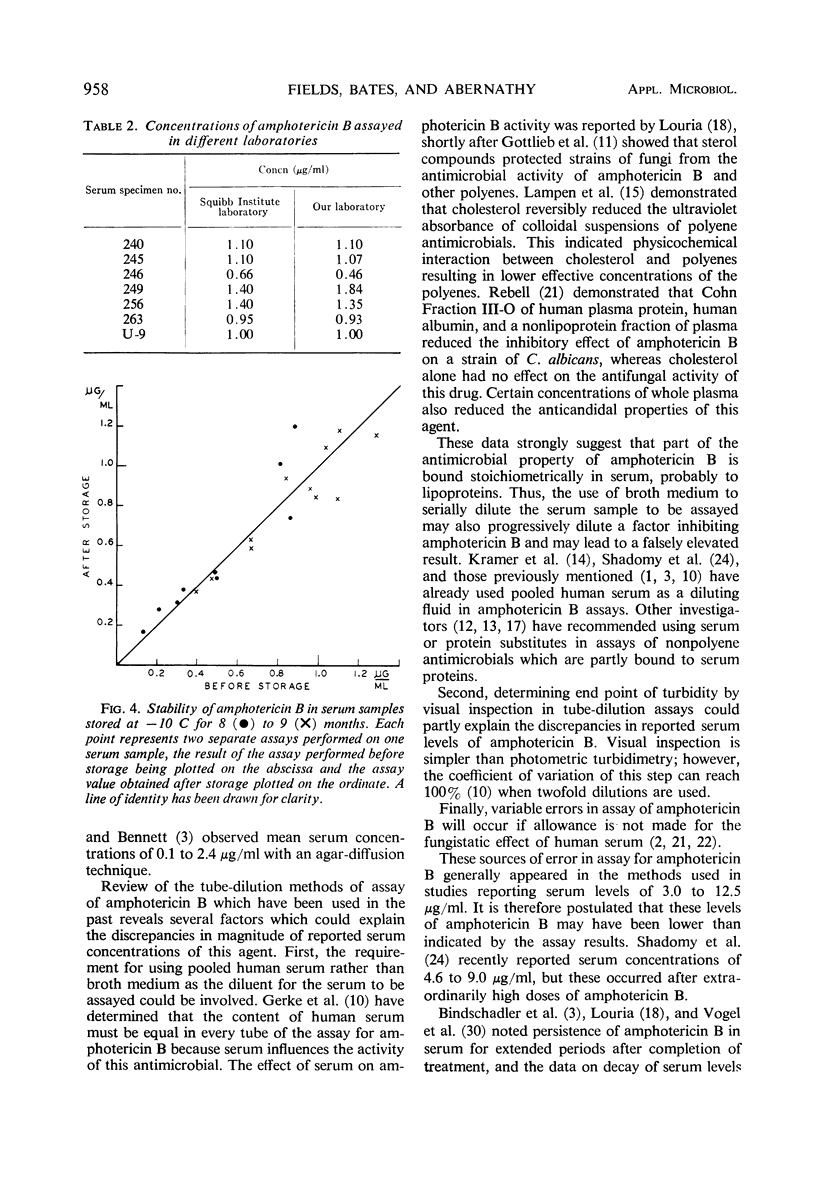Abstract
Therapeutic outcome of patients being treated for systemic mycoses with amphotericin B is possibly related to the serum concentrations of this drug that are produced in these patients. Because current data are conflicting, the magnitude of these concentrations was restudied by using a bioassay which gave precise and accurate results. The highest of 155 serum concentrations was 2.01 μg/ml. Mean concentrations were 1.21, 0.62, and 0.32 μg/ml, at 1, 18, and 42 hr, respectively, after intravenous infusion of amphotericin B. This drug was detected in serum 7 weeks after completion of treatment, but it could not be detected 13 weeks after treatment. Drug levels did not appreciably decrease in serum stored for 8 to 9 months at − 10 C. Unequal serum content in assay tubes and measurement of assay turbidity by visual inspection may explain previously reported amphotericin B levels of 3.0 to 12.5 μg/ml.
Full text
PDF




Selected References
These references are in PubMed. This may not be the complete list of references from this article.
- BAUM G. L., ARTIS D. Fungistatic effects of cell free human serum. Am J Med Sci. 1961 Dec;242:761–770. doi: 10.1097/00000441-196112000-00015. [DOI] [PubMed] [Google Scholar]
- BLOUNT J. G. BACTERIAL ENDOCARDITIS. Am J Med. 1965 Jun;38:909–922. doi: 10.1016/0002-9343(65)90010-0. [DOI] [PubMed] [Google Scholar]
- Battock D. J., Grausz H., Bobrowsky M., Littman M. L. Alternate-day amphotericin B therapy in the treatment of rhinocerebral phycomycosis (mucormycosis). Ann Intern Med. 1968 Jan;68(1):122–137. doi: 10.7326/0003-4819-68-1-122. [DOI] [PubMed] [Google Scholar]
- Bindschadler D. D., Bennett J. E. A pharmacologic guide to the clinical use of amphotericin B. J Infect Dis. 1969 Oct;120(4):427–436. doi: 10.1093/infdis/120.4.427. [DOI] [PubMed] [Google Scholar]
- Drutz D. J., Spickard A., Rogers D. E., Koenig M. G. Treatment of disseminated mycotic infectioons. A new approach to amphotericin B therapy. Am J Med. 1968 Sep;45(3):405–418. doi: 10.1016/0002-9343(68)90075-2. [DOI] [PubMed] [Google Scholar]
- GERACI J. E. The antibiotic therapy of bacterial endocarditis: therapeutic data on 172 patients seen from 1951 through 1957: additional observations on short-term therapy (two weeks) for penicillin-sensitivie streptococcal endocarditis. Med Clin North Am. 1958 Jul;42(4):1101–1140. doi: 10.1016/s0025-7125(16)34262-6. [DOI] [PubMed] [Google Scholar]
- GOTTLIEB D., CARTER H. E., SLONEKER J. H., AMMANN A. Protection of fungi against polyene antibiotics by sterols. Science. 1958 Aug 15;128(3320):361–361. doi: 10.1126/science.128.3320.361. [DOI] [PubMed] [Google Scholar]
- KRAMER J., KIRSHBAUM A. Cylinder plate assays for amphotericin B in dosage forms and body fluids. Antibiot Chemother. 1960 Mar;10:188–192. [PubMed] [Google Scholar]
- LAMPEN J. O., ARNOW P. M., SAFFERMAN R. S. Mechanism of protection by sterols against polyene antibiotics. J Bacteriol. 1960 Aug;80:200–206. doi: 10.1128/jb.80.2.200-206.1960. [DOI] [PMC free article] [PubMed] [Google Scholar]
- LITTMAN M. L., HOROWITZ P. L., SWADEY J. G. Coccidioidomycosis and its treatment with amphotericin B. Am J Med. 1958 Apr;24(4):568–592. doi: 10.1016/0002-9343(58)90297-3. [DOI] [PubMed] [Google Scholar]
- LOURIA D. B. Some aspects of the absorption, distribution, and excretion of amphotericin B in man. Antibiotic Med Clin Ther (New York) 1958 May;5(5):295–301. [PubMed] [Google Scholar]
- NEWCOMER V. D., STERNBERG T. H., WRIGHT E. T., REISNER R. M. Current status of amphotericin B in the treatment of the systemic fungus infections. J Chronic Dis. 1959 Apr;9(4):353–374. doi: 10.1016/0021-9681(59)90056-6. [DOI] [PubMed] [Google Scholar]
- Petersdorf R. G., Sherris J. C. Methods and significance of in vitro testing of bacterial sensitivity to drugs. Am J Med. 1965 Nov;39(5):766–779. doi: 10.1016/0002-9343(65)90096-3. [DOI] [PubMed] [Google Scholar]
- ROTH F. J., Jr, GOLDSTEIN M. I. Inhibition of growth of pathogenic yeasts by human serum. J Invest Dermatol. 1961 May;36:383–387. doi: 10.1038/jid.1961.59. [DOI] [PubMed] [Google Scholar]
- Rebell G. Effect of lipoproteins on hemolytic and antifungal activity of amphotericin B and other polyene antibiotics. Antimicrob Agents Chemother (Bethesda) 1966;6:411–418. doi: 10.1128/AAC.6.4.411. [DOI] [PubMed] [Google Scholar]
- SEABURY J. H., DASCOMB H. E. Experience with amphotericin B for the treatment of systemic mycoses. AMA Arch Intern Med. 1958 Dec;102(6):960–976. doi: 10.1001/archinte.1958.00260230106014. [DOI] [PubMed] [Google Scholar]
- SKEGGS L. T., Jr An automatic method for colorimetric analysis. Am J Clin Pathol. 1957 Sep;28(3):311–322. doi: 10.1093/ajcp/28.3_ts.311. [DOI] [PubMed] [Google Scholar]
- Shadomy S., McCay J. A., Schwartz S. I. Bioassay for hamycin and amphotericin B in serum and other biological fluids. Appl Microbiol. 1969 Apr;17(4):497–503. doi: 10.1128/am.17.4.497-503.1969. [DOI] [PMC free article] [PubMed] [Google Scholar]
- TUMULTY P. A. The management of bacterial endocarditis. Arch Intern Med. 1960 Jan;105:126–142. doi: 10.1001/archinte.1960.00270130142019. [DOI] [PubMed] [Google Scholar]
- VOGEL R. A., CRUTCHER J. C. Studies on the bioassay and excretion of amphotericin B in patients with systemic mycoses. Antibiotic Med Clin Ther (New York) 1958 Aug;5(8):501–506. [PubMed] [Google Scholar]
- WINN W. A. The use of amphotericin B in the treatment of coccidioidal disease. Am J Med. 1959 Oct;27:617–635. doi: 10.1016/0002-9343(59)90046-4. [DOI] [PubMed] [Google Scholar]


